Factors Influencing Recruitment and Selection: A Detailed Report
VerifiedAdded on 2020/05/28
|15
|3486
|108
Report
AI Summary
This report delves into the multifaceted aspects of recruitment and selection within the human resources domain. It begins by exploring the fundamental processes and factors that influence recruitment, including internal and external considerations. The report then examines the impact of workplace flexibility, communication, and rewards on the overall effectiveness of recruitment and selection strategies. Furthermore, it discusses the importance of employee retention, highlighting the role of job satisfaction and motivation in retaining valuable employees. The report also covers human resource selection, including screening, interviewing, and decision-making processes. It emphasizes the significance of individual differences between employers and employees and their influence on the recruitment and selection process. Finally, the report examines employee retention strategies, such as rewards systems and compensation packages, and their impact on employee motivation and overall organizational success. This report aims to provide a comprehensive overview of recruitment and selection, offering insights into the key factors and processes involved in attracting, selecting, and retaining employees.
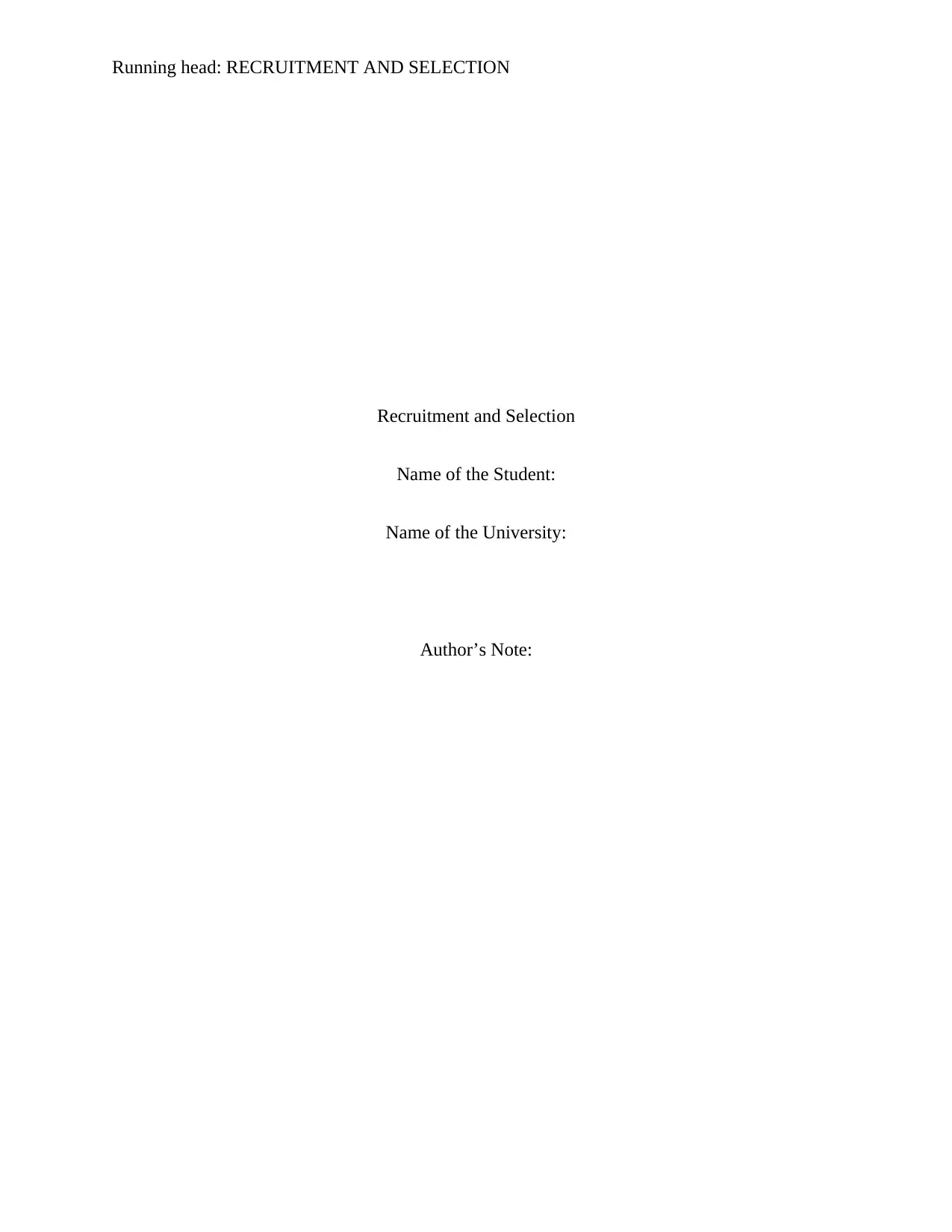
Running head: RECRUITMENT AND SELECTION
Recruitment and Selection
Name of the Student:
Name of the University:
Author’s Note:
Recruitment and Selection
Name of the Student:
Name of the University:
Author’s Note:
Paraphrase This Document
Need a fresh take? Get an instant paraphrase of this document with our AI Paraphraser
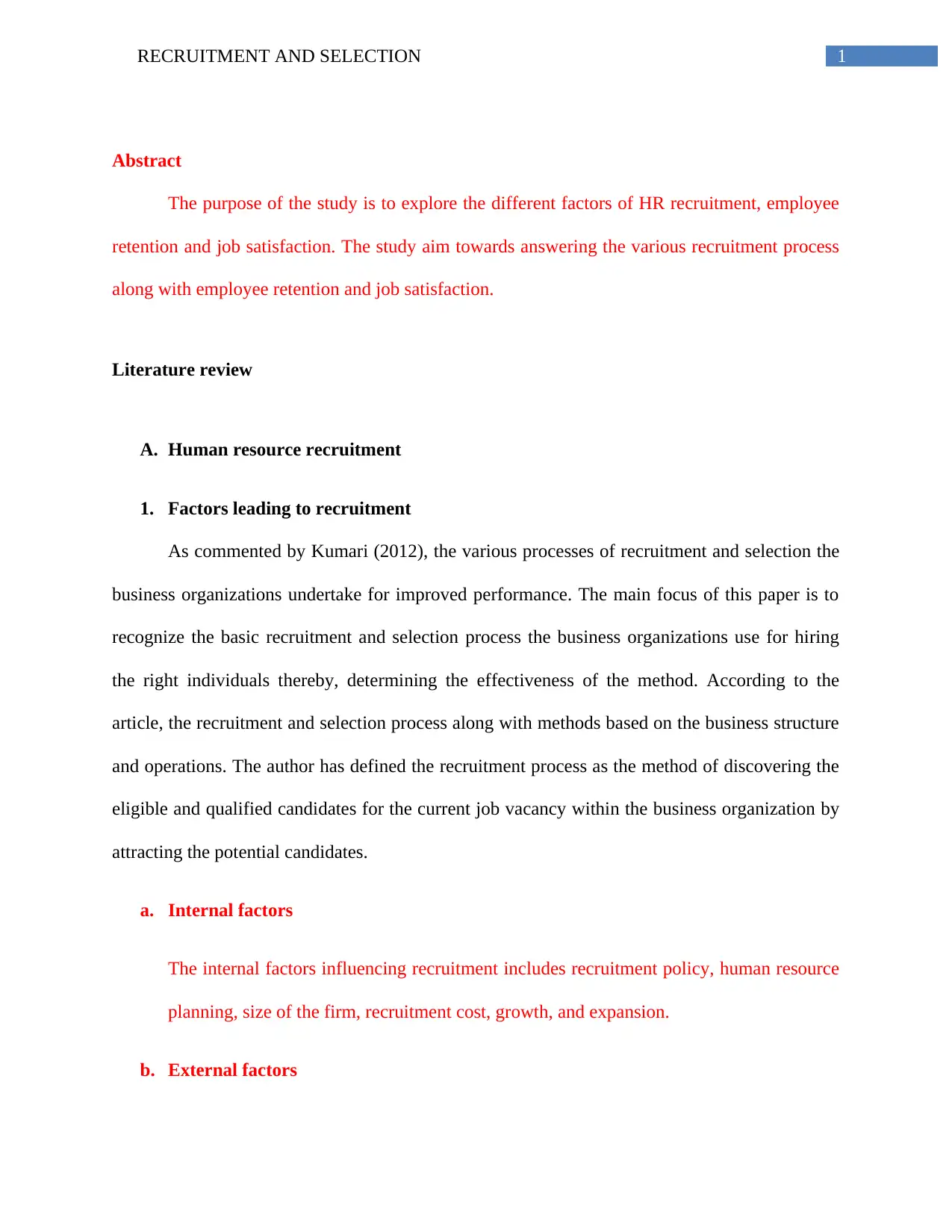
1RECRUITMENT AND SELECTION
Abstract
The purpose of the study is to explore the different factors of HR recruitment, employee
retention and job satisfaction. The study aim towards answering the various recruitment process
along with employee retention and job satisfaction.
Literature review
A. Human resource recruitment
1. Factors leading to recruitment
As commented by Kumari (2012), the various processes of recruitment and selection the
business organizations undertake for improved performance. The main focus of this paper is to
recognize the basic recruitment and selection process the business organizations use for hiring
the right individuals thereby, determining the effectiveness of the method. According to the
article, the recruitment and selection process along with methods based on the business structure
and operations. The author has defined the recruitment process as the method of discovering the
eligible and qualified candidates for the current job vacancy within the business organization by
attracting the potential candidates.
a. Internal factors
The internal factors influencing recruitment includes recruitment policy, human resource
planning, size of the firm, recruitment cost, growth, and expansion.
b. External factors
Abstract
The purpose of the study is to explore the different factors of HR recruitment, employee
retention and job satisfaction. The study aim towards answering the various recruitment process
along with employee retention and job satisfaction.
Literature review
A. Human resource recruitment
1. Factors leading to recruitment
As commented by Kumari (2012), the various processes of recruitment and selection the
business organizations undertake for improved performance. The main focus of this paper is to
recognize the basic recruitment and selection process the business organizations use for hiring
the right individuals thereby, determining the effectiveness of the method. According to the
article, the recruitment and selection process along with methods based on the business structure
and operations. The author has defined the recruitment process as the method of discovering the
eligible and qualified candidates for the current job vacancy within the business organization by
attracting the potential candidates.
a. Internal factors
The internal factors influencing recruitment includes recruitment policy, human resource
planning, size of the firm, recruitment cost, growth, and expansion.
b. External factors
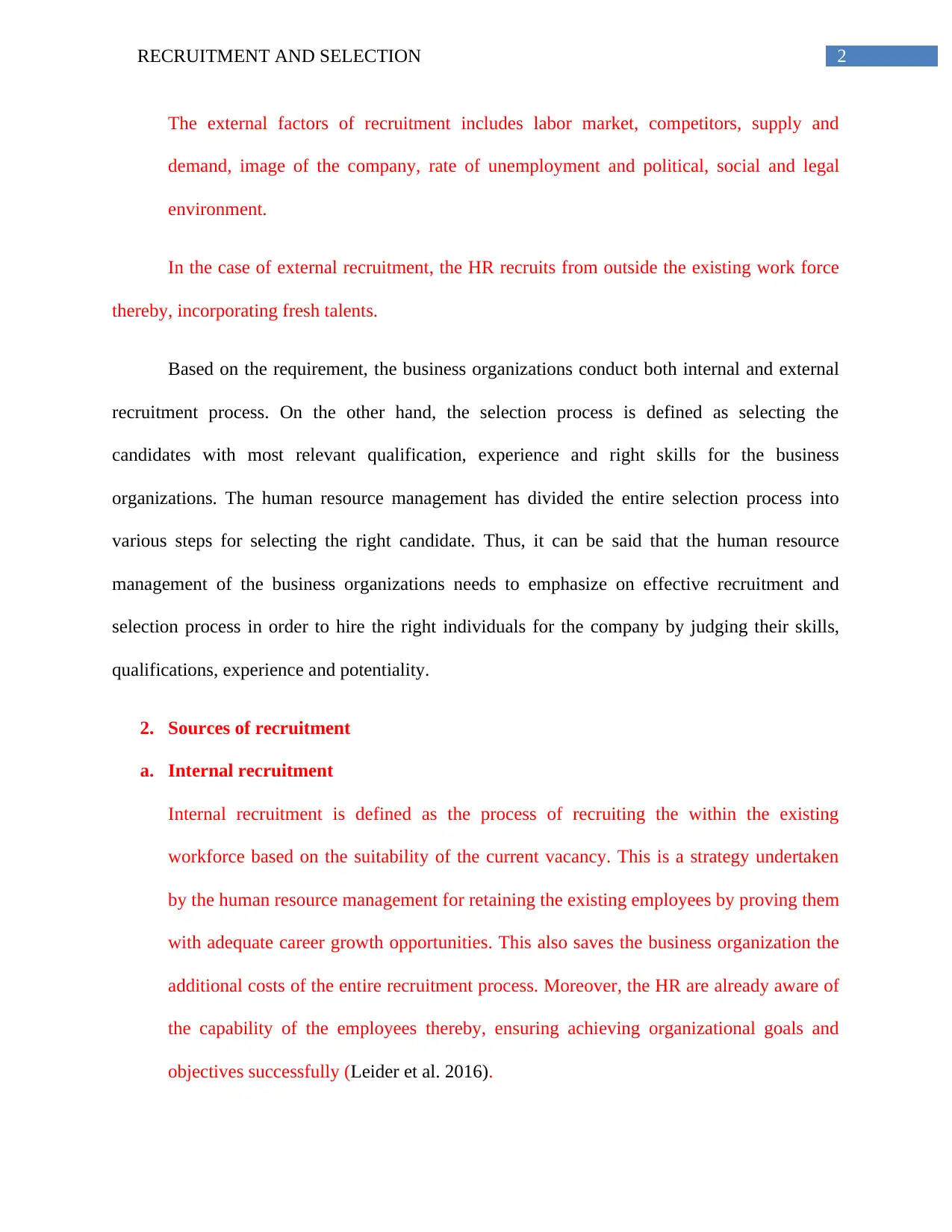
2RECRUITMENT AND SELECTION
The external factors of recruitment includes labor market, competitors, supply and
demand, image of the company, rate of unemployment and political, social and legal
environment.
In the case of external recruitment, the HR recruits from outside the existing work force
thereby, incorporating fresh talents.
Based on the requirement, the business organizations conduct both internal and external
recruitment process. On the other hand, the selection process is defined as selecting the
candidates with most relevant qualification, experience and right skills for the business
organizations. The human resource management has divided the entire selection process into
various steps for selecting the right candidate. Thus, it can be said that the human resource
management of the business organizations needs to emphasize on effective recruitment and
selection process in order to hire the right individuals for the company by judging their skills,
qualifications, experience and potentiality.
2. Sources of recruitment
a. Internal recruitment
Internal recruitment is defined as the process of recruiting the within the existing
workforce based on the suitability of the current vacancy. This is a strategy undertaken
by the human resource management for retaining the existing employees by proving them
with adequate career growth opportunities. This also saves the business organization the
additional costs of the entire recruitment process. Moreover, the HR are already aware of
the capability of the employees thereby, ensuring achieving organizational goals and
objectives successfully (Leider et al. 2016).
The external factors of recruitment includes labor market, competitors, supply and
demand, image of the company, rate of unemployment and political, social and legal
environment.
In the case of external recruitment, the HR recruits from outside the existing work force
thereby, incorporating fresh talents.
Based on the requirement, the business organizations conduct both internal and external
recruitment process. On the other hand, the selection process is defined as selecting the
candidates with most relevant qualification, experience and right skills for the business
organizations. The human resource management has divided the entire selection process into
various steps for selecting the right candidate. Thus, it can be said that the human resource
management of the business organizations needs to emphasize on effective recruitment and
selection process in order to hire the right individuals for the company by judging their skills,
qualifications, experience and potentiality.
2. Sources of recruitment
a. Internal recruitment
Internal recruitment is defined as the process of recruiting the within the existing
workforce based on the suitability of the current vacancy. This is a strategy undertaken
by the human resource management for retaining the existing employees by proving them
with adequate career growth opportunities. This also saves the business organization the
additional costs of the entire recruitment process. Moreover, the HR are already aware of
the capability of the employees thereby, ensuring achieving organizational goals and
objectives successfully (Leider et al. 2016).
⊘ This is a preview!⊘
Do you want full access?
Subscribe today to unlock all pages.

Trusted by 1+ million students worldwide
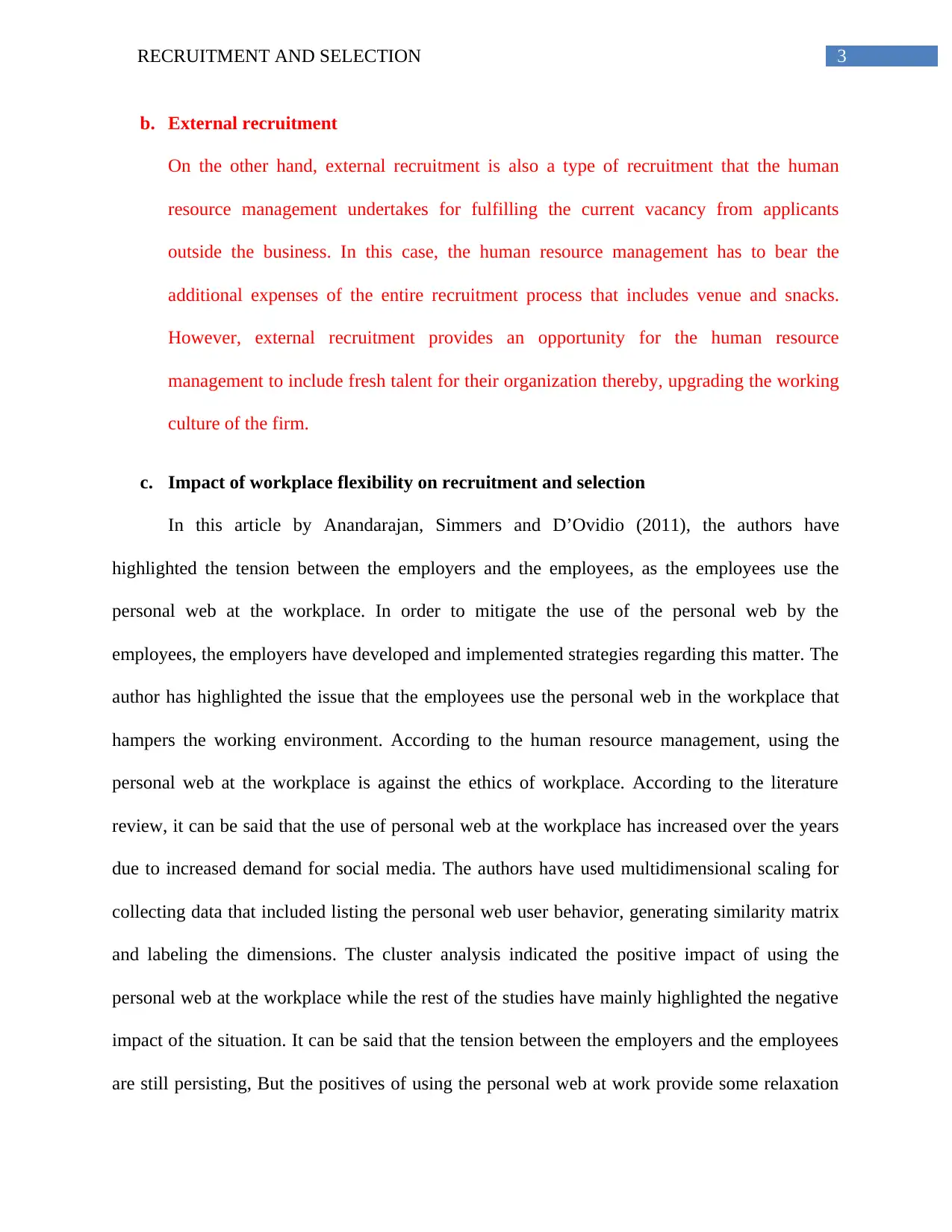
3RECRUITMENT AND SELECTION
b. External recruitment
On the other hand, external recruitment is also a type of recruitment that the human
resource management undertakes for fulfilling the current vacancy from applicants
outside the business. In this case, the human resource management has to bear the
additional expenses of the entire recruitment process that includes venue and snacks.
However, external recruitment provides an opportunity for the human resource
management to include fresh talent for their organization thereby, upgrading the working
culture of the firm.
c. Impact of workplace flexibility on recruitment and selection
In this article by Anandarajan, Simmers and D’Ovidio (2011), the authors have
highlighted the tension between the employers and the employees, as the employees use the
personal web at the workplace. In order to mitigate the use of the personal web by the
employees, the employers have developed and implemented strategies regarding this matter. The
author has highlighted the issue that the employees use the personal web in the workplace that
hampers the working environment. According to the human resource management, using the
personal web at the workplace is against the ethics of workplace. According to the literature
review, it can be said that the use of personal web at the workplace has increased over the years
due to increased demand for social media. The authors have used multidimensional scaling for
collecting data that included listing the personal web user behavior, generating similarity matrix
and labeling the dimensions. The cluster analysis indicated the positive impact of using the
personal web at the workplace while the rest of the studies have mainly highlighted the negative
impact of the situation. It can be said that the tension between the employers and the employees
are still persisting, But the positives of using the personal web at work provide some relaxation
b. External recruitment
On the other hand, external recruitment is also a type of recruitment that the human
resource management undertakes for fulfilling the current vacancy from applicants
outside the business. In this case, the human resource management has to bear the
additional expenses of the entire recruitment process that includes venue and snacks.
However, external recruitment provides an opportunity for the human resource
management to include fresh talent for their organization thereby, upgrading the working
culture of the firm.
c. Impact of workplace flexibility on recruitment and selection
In this article by Anandarajan, Simmers and D’Ovidio (2011), the authors have
highlighted the tension between the employers and the employees, as the employees use the
personal web at the workplace. In order to mitigate the use of the personal web by the
employees, the employers have developed and implemented strategies regarding this matter. The
author has highlighted the issue that the employees use the personal web in the workplace that
hampers the working environment. According to the human resource management, using the
personal web at the workplace is against the ethics of workplace. According to the literature
review, it can be said that the use of personal web at the workplace has increased over the years
due to increased demand for social media. The authors have used multidimensional scaling for
collecting data that included listing the personal web user behavior, generating similarity matrix
and labeling the dimensions. The cluster analysis indicated the positive impact of using the
personal web at the workplace while the rest of the studies have mainly highlighted the negative
impact of the situation. It can be said that the tension between the employers and the employees
are still persisting, But the positives of using the personal web at work provide some relaxation
Paraphrase This Document
Need a fresh take? Get an instant paraphrase of this document with our AI Paraphraser
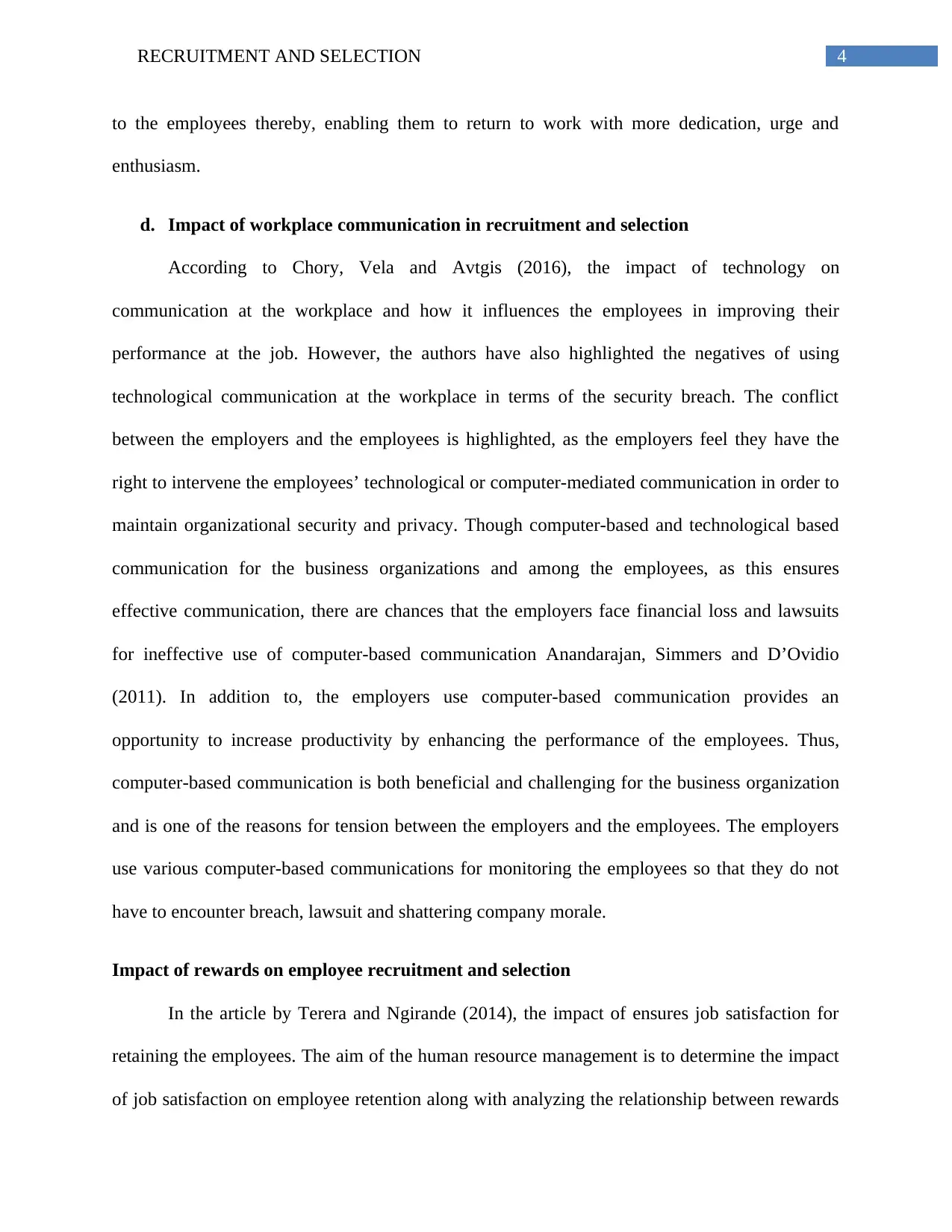
4RECRUITMENT AND SELECTION
to the employees thereby, enabling them to return to work with more dedication, urge and
enthusiasm.
d. Impact of workplace communication in recruitment and selection
According to Chory, Vela and Avtgis (2016), the impact of technology on
communication at the workplace and how it influences the employees in improving their
performance at the job. However, the authors have also highlighted the negatives of using
technological communication at the workplace in terms of the security breach. The conflict
between the employers and the employees is highlighted, as the employers feel they have the
right to intervene the employees’ technological or computer-mediated communication in order to
maintain organizational security and privacy. Though computer-based and technological based
communication for the business organizations and among the employees, as this ensures
effective communication, there are chances that the employers face financial loss and lawsuits
for ineffective use of computer-based communication Anandarajan, Simmers and D’Ovidio
(2011). In addition to, the employers use computer-based communication provides an
opportunity to increase productivity by enhancing the performance of the employees. Thus,
computer-based communication is both beneficial and challenging for the business organization
and is one of the reasons for tension between the employers and the employees. The employers
use various computer-based communications for monitoring the employees so that they do not
have to encounter breach, lawsuit and shattering company morale.
Impact of rewards on employee recruitment and selection
In the article by Terera and Ngirande (2014), the impact of ensures job satisfaction for
retaining the employees. The aim of the human resource management is to determine the impact
of job satisfaction on employee retention along with analyzing the relationship between rewards
to the employees thereby, enabling them to return to work with more dedication, urge and
enthusiasm.
d. Impact of workplace communication in recruitment and selection
According to Chory, Vela and Avtgis (2016), the impact of technology on
communication at the workplace and how it influences the employees in improving their
performance at the job. However, the authors have also highlighted the negatives of using
technological communication at the workplace in terms of the security breach. The conflict
between the employers and the employees is highlighted, as the employers feel they have the
right to intervene the employees’ technological or computer-mediated communication in order to
maintain organizational security and privacy. Though computer-based and technological based
communication for the business organizations and among the employees, as this ensures
effective communication, there are chances that the employers face financial loss and lawsuits
for ineffective use of computer-based communication Anandarajan, Simmers and D’Ovidio
(2011). In addition to, the employers use computer-based communication provides an
opportunity to increase productivity by enhancing the performance of the employees. Thus,
computer-based communication is both beneficial and challenging for the business organization
and is one of the reasons for tension between the employers and the employees. The employers
use various computer-based communications for monitoring the employees so that they do not
have to encounter breach, lawsuit and shattering company morale.
Impact of rewards on employee recruitment and selection
In the article by Terera and Ngirande (2014), the impact of ensures job satisfaction for
retaining the employees. The aim of the human resource management is to determine the impact
of job satisfaction on employee retention along with analyzing the relationship between rewards
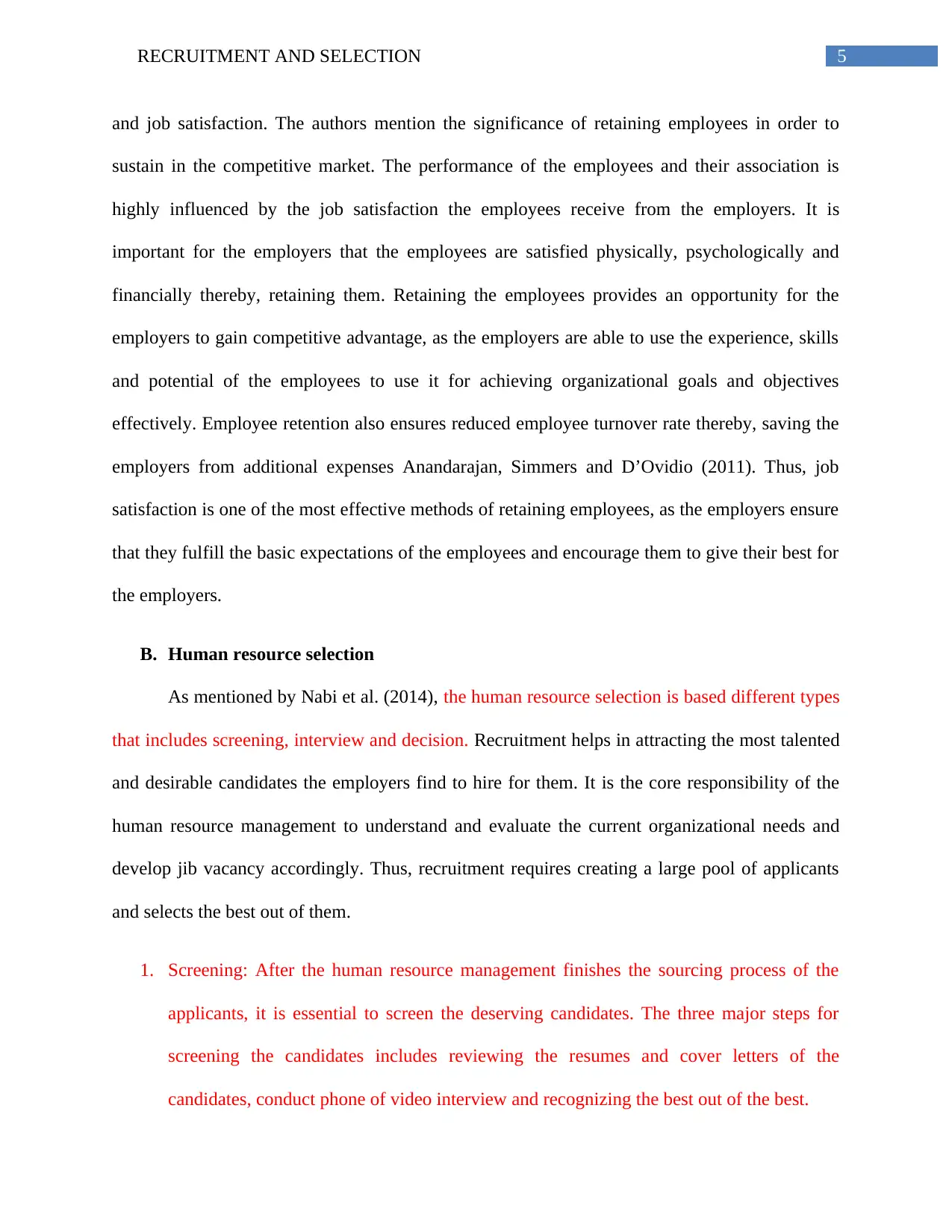
5RECRUITMENT AND SELECTION
and job satisfaction. The authors mention the significance of retaining employees in order to
sustain in the competitive market. The performance of the employees and their association is
highly influenced by the job satisfaction the employees receive from the employers. It is
important for the employers that the employees are satisfied physically, psychologically and
financially thereby, retaining them. Retaining the employees provides an opportunity for the
employers to gain competitive advantage, as the employers are able to use the experience, skills
and potential of the employees to use it for achieving organizational goals and objectives
effectively. Employee retention also ensures reduced employee turnover rate thereby, saving the
employers from additional expenses Anandarajan, Simmers and D’Ovidio (2011). Thus, job
satisfaction is one of the most effective methods of retaining employees, as the employers ensure
that they fulfill the basic expectations of the employees and encourage them to give their best for
the employers.
B. Human resource selection
As mentioned by Nabi et al. (2014), the human resource selection is based different types
that includes screening, interview and decision. Recruitment helps in attracting the most talented
and desirable candidates the employers find to hire for them. It is the core responsibility of the
human resource management to understand and evaluate the current organizational needs and
develop jib vacancy accordingly. Thus, recruitment requires creating a large pool of applicants
and selects the best out of them.
1. Screening: After the human resource management finishes the sourcing process of the
applicants, it is essential to screen the deserving candidates. The three major steps for
screening the candidates includes reviewing the resumes and cover letters of the
candidates, conduct phone of video interview and recognizing the best out of the best.
and job satisfaction. The authors mention the significance of retaining employees in order to
sustain in the competitive market. The performance of the employees and their association is
highly influenced by the job satisfaction the employees receive from the employers. It is
important for the employers that the employees are satisfied physically, psychologically and
financially thereby, retaining them. Retaining the employees provides an opportunity for the
employers to gain competitive advantage, as the employers are able to use the experience, skills
and potential of the employees to use it for achieving organizational goals and objectives
effectively. Employee retention also ensures reduced employee turnover rate thereby, saving the
employers from additional expenses Anandarajan, Simmers and D’Ovidio (2011). Thus, job
satisfaction is one of the most effective methods of retaining employees, as the employers ensure
that they fulfill the basic expectations of the employees and encourage them to give their best for
the employers.
B. Human resource selection
As mentioned by Nabi et al. (2014), the human resource selection is based different types
that includes screening, interview and decision. Recruitment helps in attracting the most talented
and desirable candidates the employers find to hire for them. It is the core responsibility of the
human resource management to understand and evaluate the current organizational needs and
develop jib vacancy accordingly. Thus, recruitment requires creating a large pool of applicants
and selects the best out of them.
1. Screening: After the human resource management finishes the sourcing process of the
applicants, it is essential to screen the deserving candidates. The three major steps for
screening the candidates includes reviewing the resumes and cover letters of the
candidates, conduct phone of video interview and recognizing the best out of the best.
⊘ This is a preview!⊘
Do you want full access?
Subscribe today to unlock all pages.

Trusted by 1+ million students worldwide
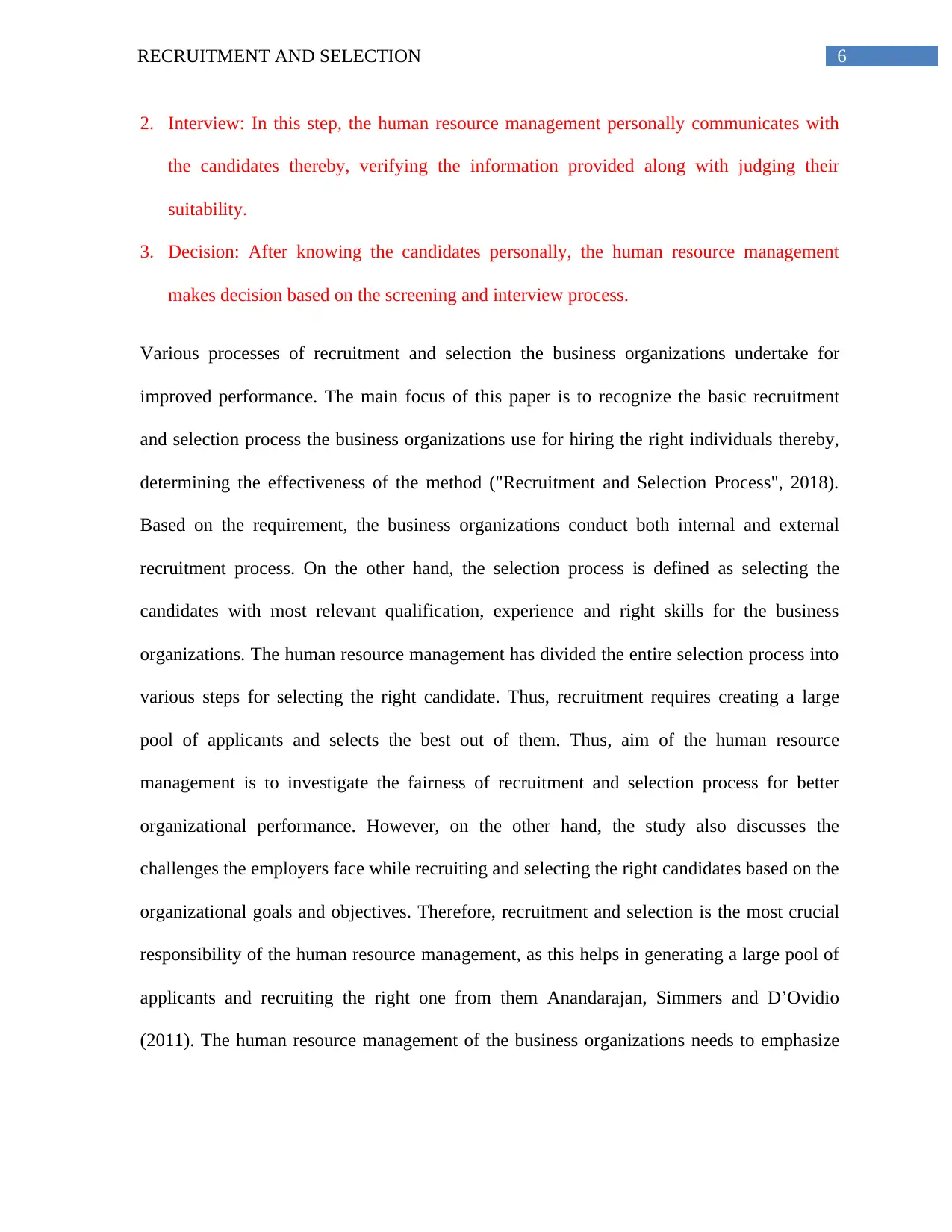
6RECRUITMENT AND SELECTION
2. Interview: In this step, the human resource management personally communicates with
the candidates thereby, verifying the information provided along with judging their
suitability.
3. Decision: After knowing the candidates personally, the human resource management
makes decision based on the screening and interview process.
Various processes of recruitment and selection the business organizations undertake for
improved performance. The main focus of this paper is to recognize the basic recruitment
and selection process the business organizations use for hiring the right individuals thereby,
determining the effectiveness of the method ("Recruitment and Selection Process", 2018).
Based on the requirement, the business organizations conduct both internal and external
recruitment process. On the other hand, the selection process is defined as selecting the
candidates with most relevant qualification, experience and right skills for the business
organizations. The human resource management has divided the entire selection process into
various steps for selecting the right candidate. Thus, recruitment requires creating a large
pool of applicants and selects the best out of them. Thus, aim of the human resource
management is to investigate the fairness of recruitment and selection process for better
organizational performance. However, on the other hand, the study also discusses the
challenges the employers face while recruiting and selecting the right candidates based on the
organizational goals and objectives. Therefore, recruitment and selection is the most crucial
responsibility of the human resource management, as this helps in generating a large pool of
applicants and recruiting the right one from them Anandarajan, Simmers and D’Ovidio
(2011). The human resource management of the business organizations needs to emphasize
2. Interview: In this step, the human resource management personally communicates with
the candidates thereby, verifying the information provided along with judging their
suitability.
3. Decision: After knowing the candidates personally, the human resource management
makes decision based on the screening and interview process.
Various processes of recruitment and selection the business organizations undertake for
improved performance. The main focus of this paper is to recognize the basic recruitment
and selection process the business organizations use for hiring the right individuals thereby,
determining the effectiveness of the method ("Recruitment and Selection Process", 2018).
Based on the requirement, the business organizations conduct both internal and external
recruitment process. On the other hand, the selection process is defined as selecting the
candidates with most relevant qualification, experience and right skills for the business
organizations. The human resource management has divided the entire selection process into
various steps for selecting the right candidate. Thus, recruitment requires creating a large
pool of applicants and selects the best out of them. Thus, aim of the human resource
management is to investigate the fairness of recruitment and selection process for better
organizational performance. However, on the other hand, the study also discusses the
challenges the employers face while recruiting and selecting the right candidates based on the
organizational goals and objectives. Therefore, recruitment and selection is the most crucial
responsibility of the human resource management, as this helps in generating a large pool of
applicants and recruiting the right one from them Anandarajan, Simmers and D’Ovidio
(2011). The human resource management of the business organizations needs to emphasize
Paraphrase This Document
Need a fresh take? Get an instant paraphrase of this document with our AI Paraphraser
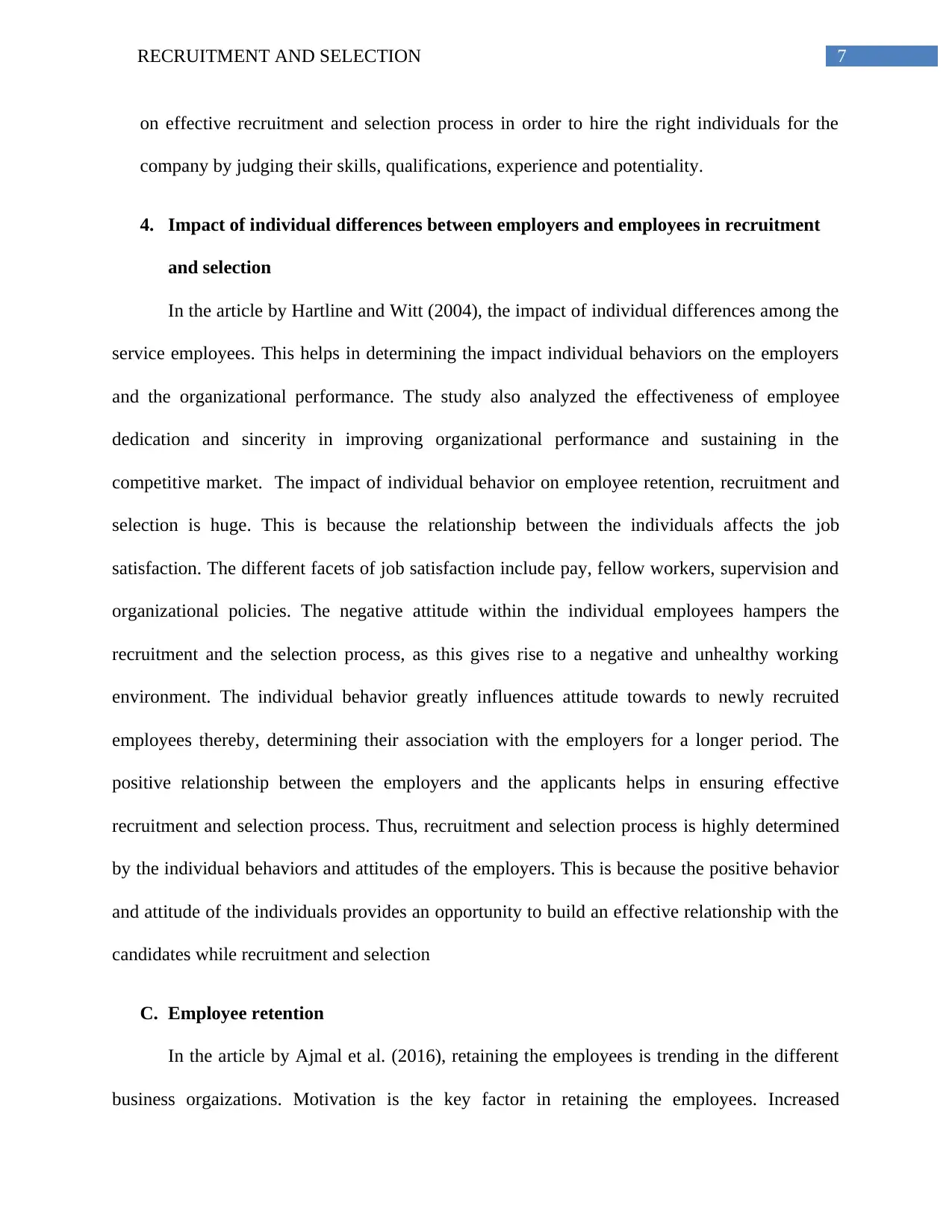
7RECRUITMENT AND SELECTION
on effective recruitment and selection process in order to hire the right individuals for the
company by judging their skills, qualifications, experience and potentiality.
4. Impact of individual differences between employers and employees in recruitment
and selection
In the article by Hartline and Witt (2004), the impact of individual differences among the
service employees. This helps in determining the impact individual behaviors on the employers
and the organizational performance. The study also analyzed the effectiveness of employee
dedication and sincerity in improving organizational performance and sustaining in the
competitive market. The impact of individual behavior on employee retention, recruitment and
selection is huge. This is because the relationship between the individuals affects the job
satisfaction. The different facets of job satisfaction include pay, fellow workers, supervision and
organizational policies. The negative attitude within the individual employees hampers the
recruitment and the selection process, as this gives rise to a negative and unhealthy working
environment. The individual behavior greatly influences attitude towards to newly recruited
employees thereby, determining their association with the employers for a longer period. The
positive relationship between the employers and the applicants helps in ensuring effective
recruitment and selection process. Thus, recruitment and selection process is highly determined
by the individual behaviors and attitudes of the employers. This is because the positive behavior
and attitude of the individuals provides an opportunity to build an effective relationship with the
candidates while recruitment and selection
C. Employee retention
In the article by Ajmal et al. (2016), retaining the employees is trending in the different
business orgaizations. Motivation is the key factor in retaining the employees. Increased
on effective recruitment and selection process in order to hire the right individuals for the
company by judging their skills, qualifications, experience and potentiality.
4. Impact of individual differences between employers and employees in recruitment
and selection
In the article by Hartline and Witt (2004), the impact of individual differences among the
service employees. This helps in determining the impact individual behaviors on the employers
and the organizational performance. The study also analyzed the effectiveness of employee
dedication and sincerity in improving organizational performance and sustaining in the
competitive market. The impact of individual behavior on employee retention, recruitment and
selection is huge. This is because the relationship between the individuals affects the job
satisfaction. The different facets of job satisfaction include pay, fellow workers, supervision and
organizational policies. The negative attitude within the individual employees hampers the
recruitment and the selection process, as this gives rise to a negative and unhealthy working
environment. The individual behavior greatly influences attitude towards to newly recruited
employees thereby, determining their association with the employers for a longer period. The
positive relationship between the employers and the applicants helps in ensuring effective
recruitment and selection process. Thus, recruitment and selection process is highly determined
by the individual behaviors and attitudes of the employers. This is because the positive behavior
and attitude of the individuals provides an opportunity to build an effective relationship with the
candidates while recruitment and selection
C. Employee retention
In the article by Ajmal et al. (2016), retaining the employees is trending in the different
business orgaizations. Motivation is the key factor in retaining the employees. Increased
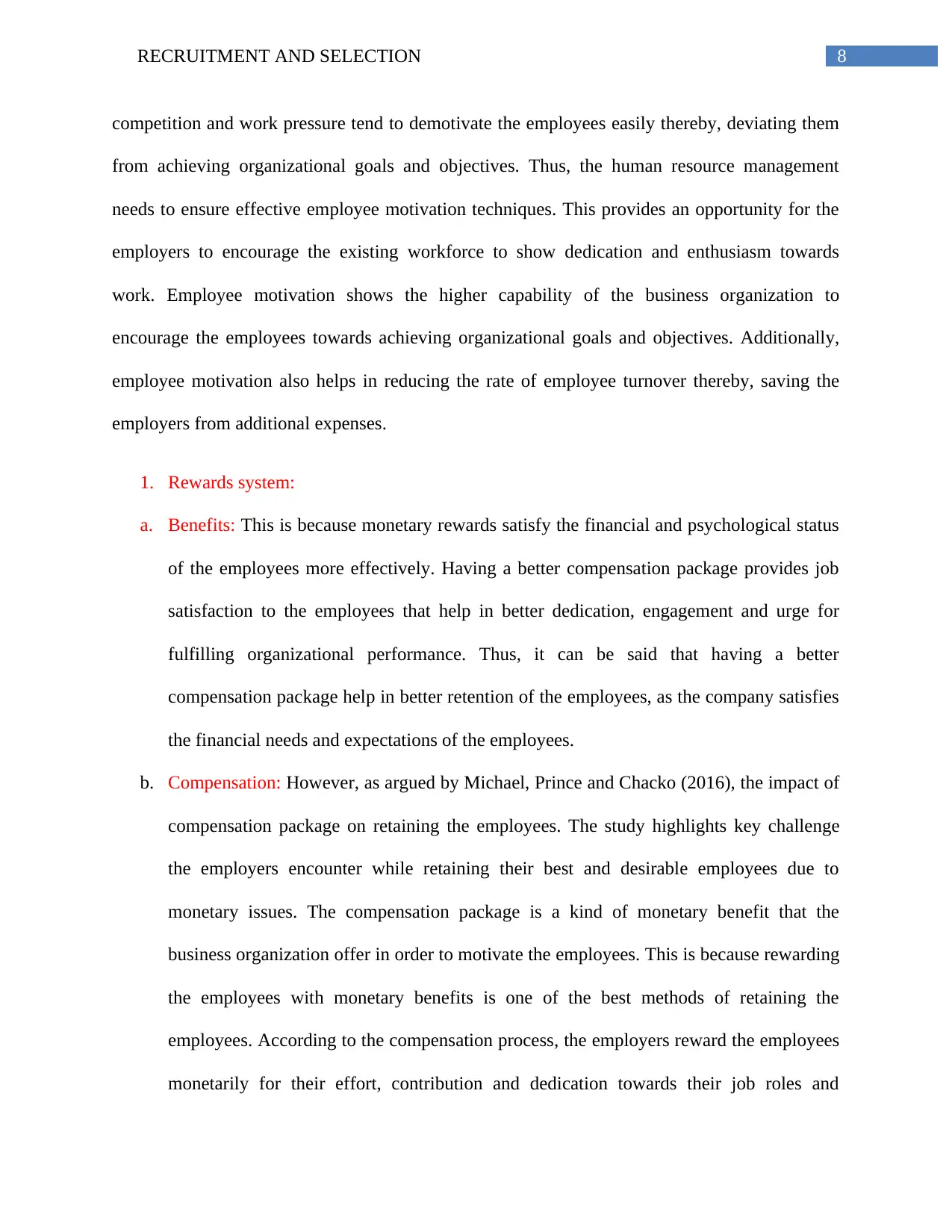
8RECRUITMENT AND SELECTION
competition and work pressure tend to demotivate the employees easily thereby, deviating them
from achieving organizational goals and objectives. Thus, the human resource management
needs to ensure effective employee motivation techniques. This provides an opportunity for the
employers to encourage the existing workforce to show dedication and enthusiasm towards
work. Employee motivation shows the higher capability of the business organization to
encourage the employees towards achieving organizational goals and objectives. Additionally,
employee motivation also helps in reducing the rate of employee turnover thereby, saving the
employers from additional expenses.
1. Rewards system:
a. Benefits: This is because monetary rewards satisfy the financial and psychological status
of the employees more effectively. Having a better compensation package provides job
satisfaction to the employees that help in better dedication, engagement and urge for
fulfilling organizational performance. Thus, it can be said that having a better
compensation package help in better retention of the employees, as the company satisfies
the financial needs and expectations of the employees.
b. Compensation: However, as argued by Michael, Prince and Chacko (2016), the impact of
compensation package on retaining the employees. The study highlights key challenge
the employers encounter while retaining their best and desirable employees due to
monetary issues. The compensation package is a kind of monetary benefit that the
business organization offer in order to motivate the employees. This is because rewarding
the employees with monetary benefits is one of the best methods of retaining the
employees. According to the compensation process, the employers reward the employees
monetarily for their effort, contribution and dedication towards their job roles and
competition and work pressure tend to demotivate the employees easily thereby, deviating them
from achieving organizational goals and objectives. Thus, the human resource management
needs to ensure effective employee motivation techniques. This provides an opportunity for the
employers to encourage the existing workforce to show dedication and enthusiasm towards
work. Employee motivation shows the higher capability of the business organization to
encourage the employees towards achieving organizational goals and objectives. Additionally,
employee motivation also helps in reducing the rate of employee turnover thereby, saving the
employers from additional expenses.
1. Rewards system:
a. Benefits: This is because monetary rewards satisfy the financial and psychological status
of the employees more effectively. Having a better compensation package provides job
satisfaction to the employees that help in better dedication, engagement and urge for
fulfilling organizational performance. Thus, it can be said that having a better
compensation package help in better retention of the employees, as the company satisfies
the financial needs and expectations of the employees.
b. Compensation: However, as argued by Michael, Prince and Chacko (2016), the impact of
compensation package on retaining the employees. The study highlights key challenge
the employers encounter while retaining their best and desirable employees due to
monetary issues. The compensation package is a kind of monetary benefit that the
business organization offer in order to motivate the employees. This is because rewarding
the employees with monetary benefits is one of the best methods of retaining the
employees. According to the compensation process, the employers reward the employees
monetarily for their effort, contribution and dedication towards their job roles and
⊘ This is a preview!⊘
Do you want full access?
Subscribe today to unlock all pages.

Trusted by 1+ million students worldwide
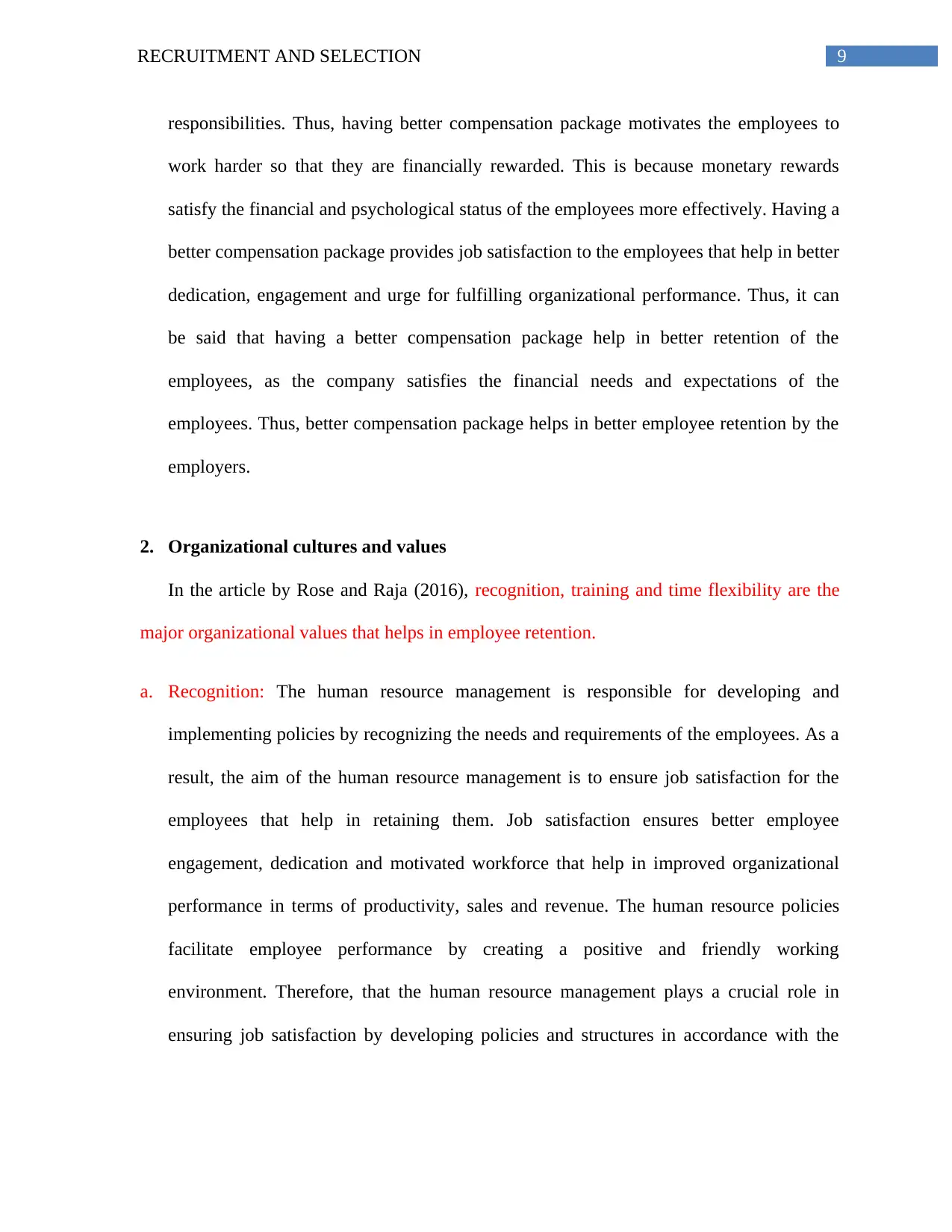
9RECRUITMENT AND SELECTION
responsibilities. Thus, having better compensation package motivates the employees to
work harder so that they are financially rewarded. This is because monetary rewards
satisfy the financial and psychological status of the employees more effectively. Having a
better compensation package provides job satisfaction to the employees that help in better
dedication, engagement and urge for fulfilling organizational performance. Thus, it can
be said that having a better compensation package help in better retention of the
employees, as the company satisfies the financial needs and expectations of the
employees. Thus, better compensation package helps in better employee retention by the
employers.
2. Organizational cultures and values
In the article by Rose and Raja (2016), recognition, training and time flexibility are the
major organizational values that helps in employee retention.
a. Recognition: The human resource management is responsible for developing and
implementing policies by recognizing the needs and requirements of the employees. As a
result, the aim of the human resource management is to ensure job satisfaction for the
employees that help in retaining them. Job satisfaction ensures better employee
engagement, dedication and motivated workforce that help in improved organizational
performance in terms of productivity, sales and revenue. The human resource policies
facilitate employee performance by creating a positive and friendly working
environment. Therefore, that the human resource management plays a crucial role in
ensuring job satisfaction by developing policies and structures in accordance with the
responsibilities. Thus, having better compensation package motivates the employees to
work harder so that they are financially rewarded. This is because monetary rewards
satisfy the financial and psychological status of the employees more effectively. Having a
better compensation package provides job satisfaction to the employees that help in better
dedication, engagement and urge for fulfilling organizational performance. Thus, it can
be said that having a better compensation package help in better retention of the
employees, as the company satisfies the financial needs and expectations of the
employees. Thus, better compensation package helps in better employee retention by the
employers.
2. Organizational cultures and values
In the article by Rose and Raja (2016), recognition, training and time flexibility are the
major organizational values that helps in employee retention.
a. Recognition: The human resource management is responsible for developing and
implementing policies by recognizing the needs and requirements of the employees. As a
result, the aim of the human resource management is to ensure job satisfaction for the
employees that help in retaining them. Job satisfaction ensures better employee
engagement, dedication and motivated workforce that help in improved organizational
performance in terms of productivity, sales and revenue. The human resource policies
facilitate employee performance by creating a positive and friendly working
environment. Therefore, that the human resource management plays a crucial role in
ensuring job satisfaction by developing policies and structures in accordance with the
Paraphrase This Document
Need a fresh take? Get an instant paraphrase of this document with our AI Paraphraser
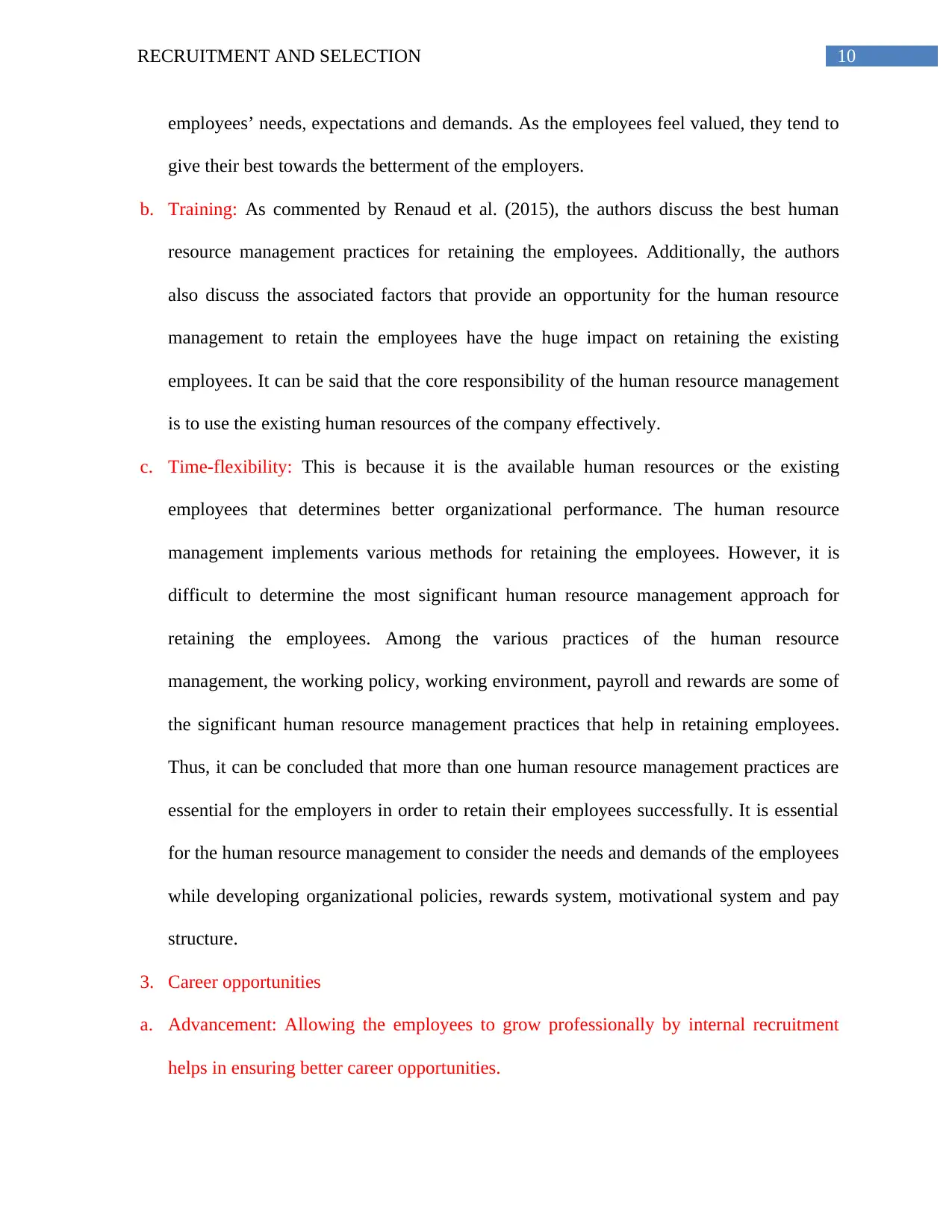
10RECRUITMENT AND SELECTION
employees’ needs, expectations and demands. As the employees feel valued, they tend to
give their best towards the betterment of the employers.
b. Training: As commented by Renaud et al. (2015), the authors discuss the best human
resource management practices for retaining the employees. Additionally, the authors
also discuss the associated factors that provide an opportunity for the human resource
management to retain the employees have the huge impact on retaining the existing
employees. It can be said that the core responsibility of the human resource management
is to use the existing human resources of the company effectively.
c. Time-flexibility: This is because it is the available human resources or the existing
employees that determines better organizational performance. The human resource
management implements various methods for retaining the employees. However, it is
difficult to determine the most significant human resource management approach for
retaining the employees. Among the various practices of the human resource
management, the working policy, working environment, payroll and rewards are some of
the significant human resource management practices that help in retaining employees.
Thus, it can be concluded that more than one human resource management practices are
essential for the employers in order to retain their employees successfully. It is essential
for the human resource management to consider the needs and demands of the employees
while developing organizational policies, rewards system, motivational system and pay
structure.
3. Career opportunities
a. Advancement: Allowing the employees to grow professionally by internal recruitment
helps in ensuring better career opportunities.
employees’ needs, expectations and demands. As the employees feel valued, they tend to
give their best towards the betterment of the employers.
b. Training: As commented by Renaud et al. (2015), the authors discuss the best human
resource management practices for retaining the employees. Additionally, the authors
also discuss the associated factors that provide an opportunity for the human resource
management to retain the employees have the huge impact on retaining the existing
employees. It can be said that the core responsibility of the human resource management
is to use the existing human resources of the company effectively.
c. Time-flexibility: This is because it is the available human resources or the existing
employees that determines better organizational performance. The human resource
management implements various methods for retaining the employees. However, it is
difficult to determine the most significant human resource management approach for
retaining the employees. Among the various practices of the human resource
management, the working policy, working environment, payroll and rewards are some of
the significant human resource management practices that help in retaining employees.
Thus, it can be concluded that more than one human resource management practices are
essential for the employers in order to retain their employees successfully. It is essential
for the human resource management to consider the needs and demands of the employees
while developing organizational policies, rewards system, motivational system and pay
structure.
3. Career opportunities
a. Advancement: Allowing the employees to grow professionally by internal recruitment
helps in ensuring better career opportunities.
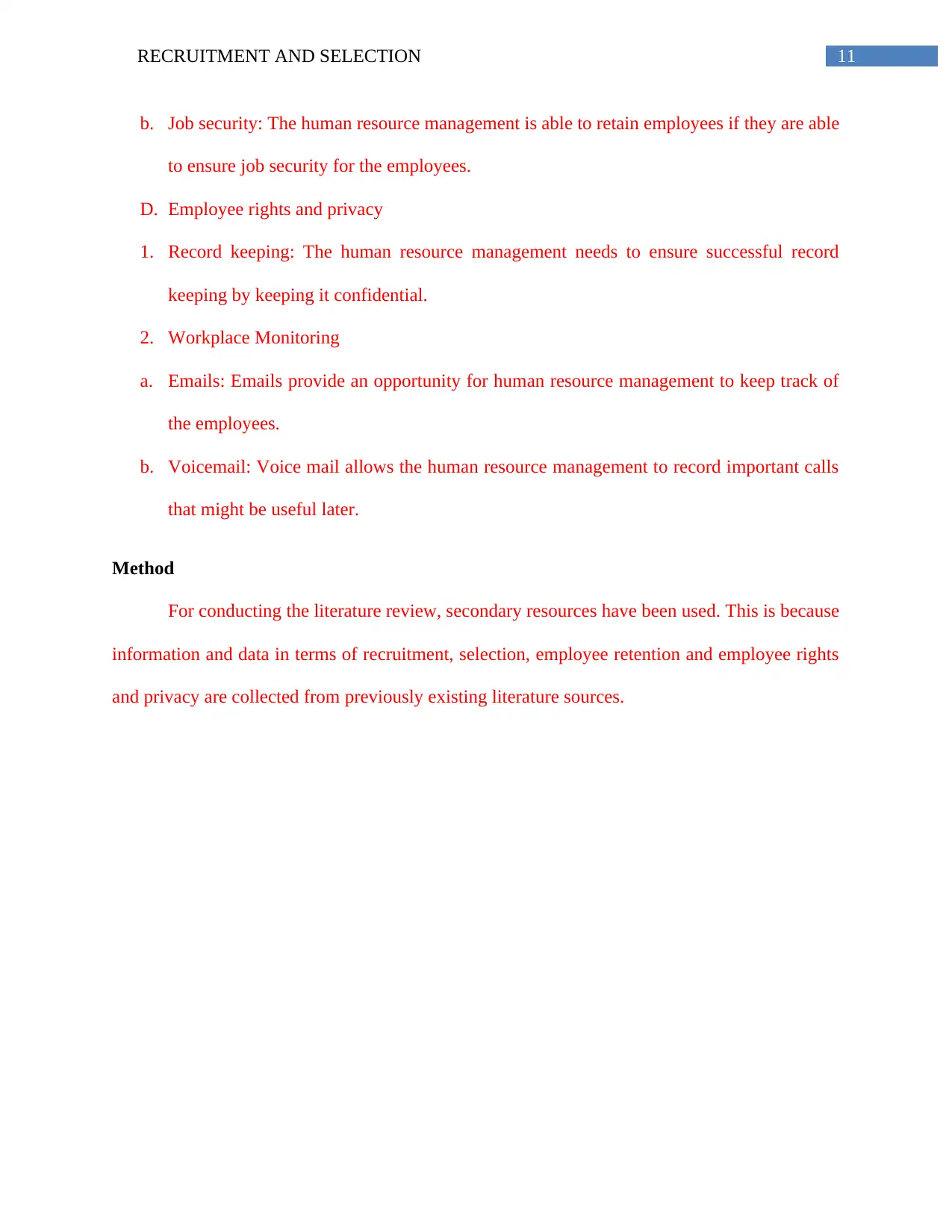
11RECRUITMENT AND SELECTION
b. Job security: The human resource management is able to retain employees if they are able
to ensure job security for the employees.
D. Employee rights and privacy
1. Record keeping: The human resource management needs to ensure successful record
keeping by keeping it confidential.
2. Workplace Monitoring
a. Emails: Emails provide an opportunity for human resource management to keep track of
the employees.
b. Voicemail: Voice mail allows the human resource management to record important calls
that might be useful later.
Method
For conducting the literature review, secondary resources have been used. This is because
information and data in terms of recruitment, selection, employee retention and employee rights
and privacy are collected from previously existing literature sources.
b. Job security: The human resource management is able to retain employees if they are able
to ensure job security for the employees.
D. Employee rights and privacy
1. Record keeping: The human resource management needs to ensure successful record
keeping by keeping it confidential.
2. Workplace Monitoring
a. Emails: Emails provide an opportunity for human resource management to keep track of
the employees.
b. Voicemail: Voice mail allows the human resource management to record important calls
that might be useful later.
Method
For conducting the literature review, secondary resources have been used. This is because
information and data in terms of recruitment, selection, employee retention and employee rights
and privacy are collected from previously existing literature sources.
⊘ This is a preview!⊘
Do you want full access?
Subscribe today to unlock all pages.

Trusted by 1+ million students worldwide
1 out of 15
Related Documents
Your All-in-One AI-Powered Toolkit for Academic Success.
+13062052269
info@desklib.com
Available 24*7 on WhatsApp / Email
![[object Object]](/_next/static/media/star-bottom.7253800d.svg)
Unlock your academic potential
Copyright © 2020–2025 A2Z Services. All Rights Reserved. Developed and managed by ZUCOL.





